PUBH6003: Applying Systems Thinking to Obesity Prevention Programs
VerifiedAdded on 2022/08/25
|9
|1736
|18
Report
AI Summary
This report, prepared for the PUBH6003 course, examines the application of systems thinking to address the public health issue of obesity. It identifies key stakeholders, including healthcare professionals, academic institutions, and funding organizations, and explores their roles in obesity prevention programs. The report highlights the obstacles to implementing a systems thinking approach, such as funding limitations, complex support networks, and the need for unified system measures. It also provides recommendations for improving the effectiveness of obesity programs by fostering collaboration, recognizing system paradigms, and incorporating feedback into research. The analysis underscores the importance of a holistic approach that considers the multifaceted nature of obesity and the diverse perspectives of those involved in prevention and treatment efforts.
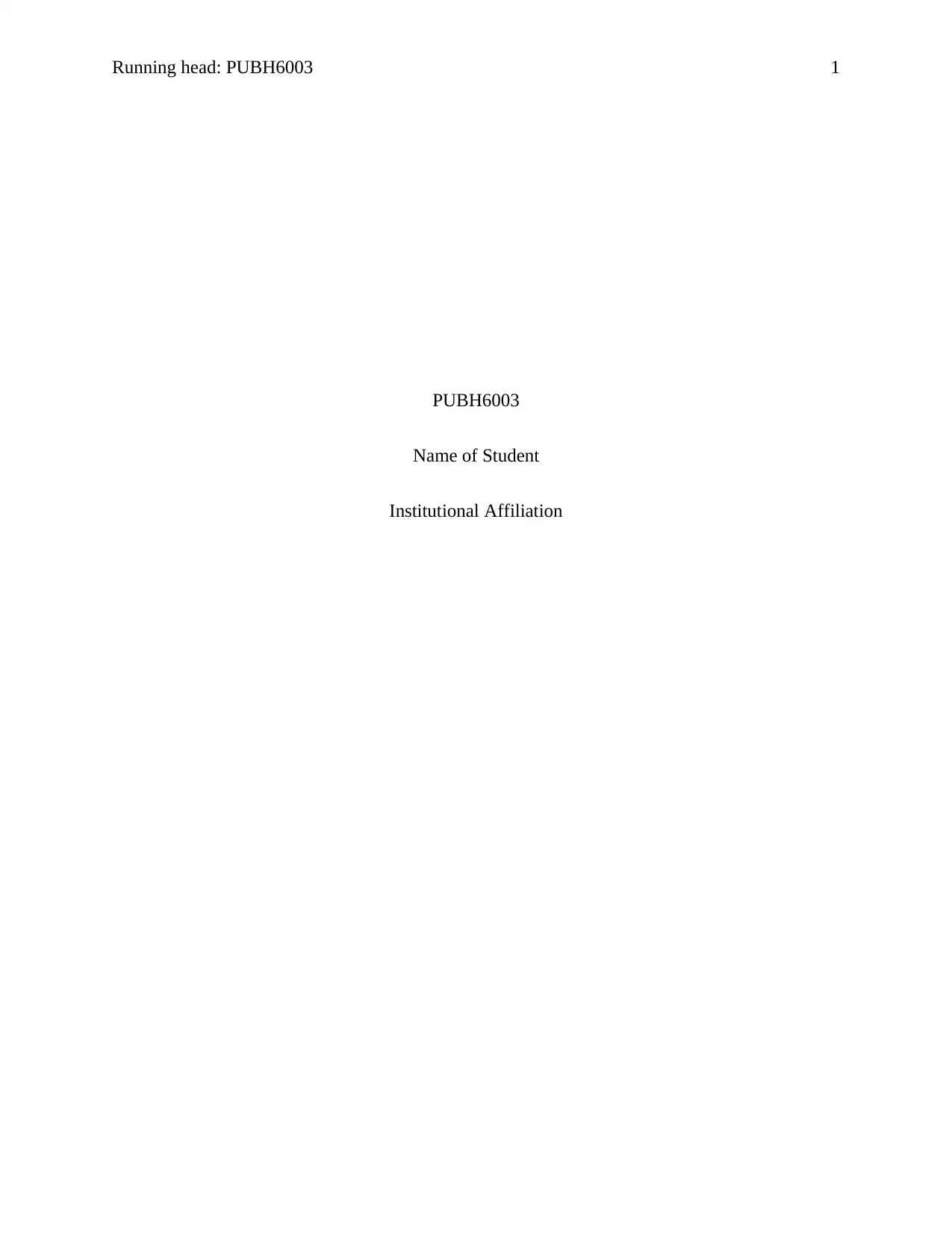
Running head: PUBH6003 1
PUBH6003
Name of Student
Institutional Affiliation
PUBH6003
Name of Student
Institutional Affiliation
Paraphrase This Document
Need a fresh take? Get an instant paraphrase of this document with our AI Paraphraser
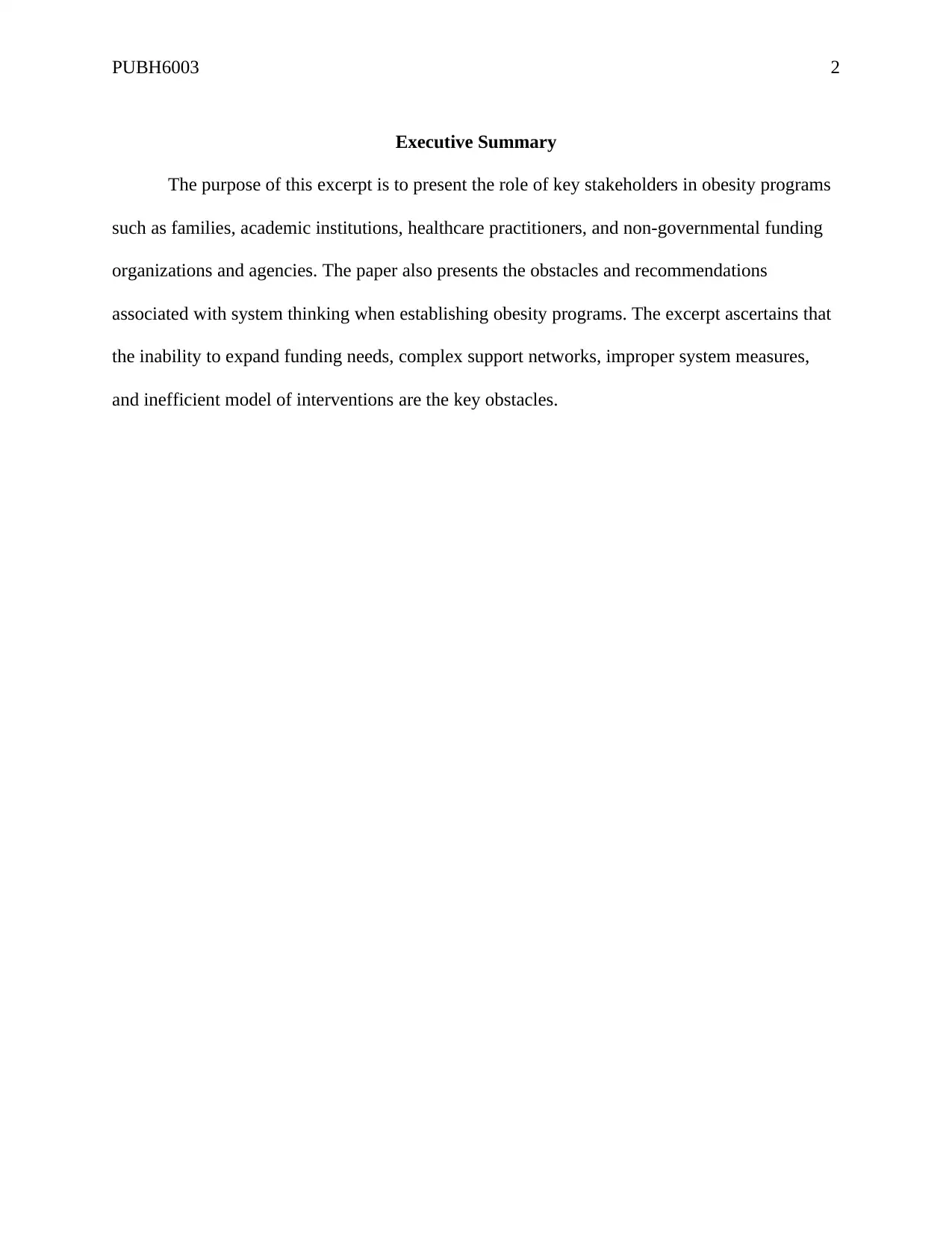
PUBH6003 2
Executive Summary
The purpose of this excerpt is to present the role of key stakeholders in obesity programs
such as families, academic institutions, healthcare practitioners, and non-governmental funding
organizations and agencies. The paper also presents the obstacles and recommendations
associated with system thinking when establishing obesity programs. The excerpt ascertains that
the inability to expand funding needs, complex support networks, improper system measures,
and inefficient model of interventions are the key obstacles.
Executive Summary
The purpose of this excerpt is to present the role of key stakeholders in obesity programs
such as families, academic institutions, healthcare practitioners, and non-governmental funding
organizations and agencies. The paper also presents the obstacles and recommendations
associated with system thinking when establishing obesity programs. The excerpt ascertains that
the inability to expand funding needs, complex support networks, improper system measures,
and inefficient model of interventions are the key obstacles.
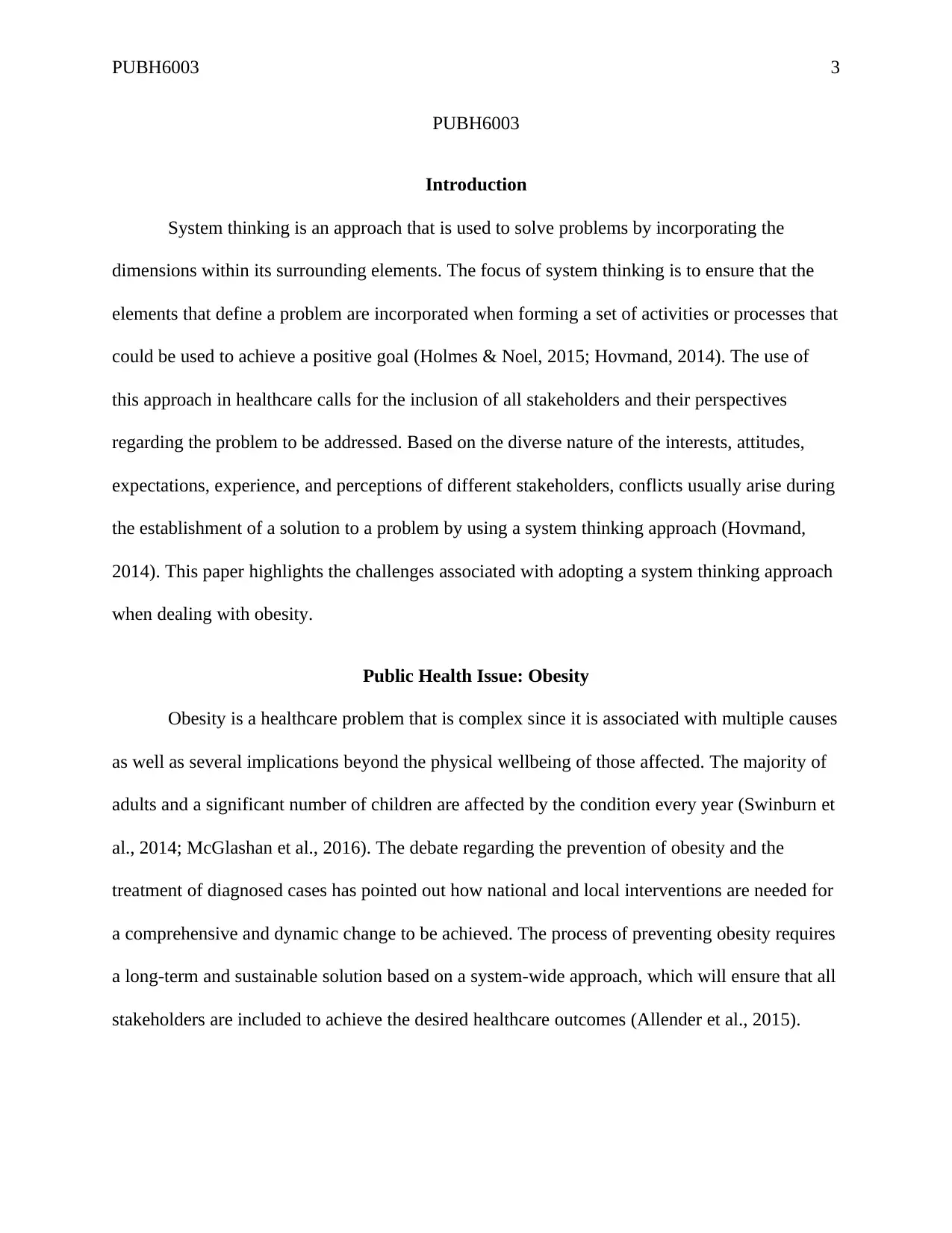
PUBH6003 3
PUBH6003
Introduction
System thinking is an approach that is used to solve problems by incorporating the
dimensions within its surrounding elements. The focus of system thinking is to ensure that the
elements that define a problem are incorporated when forming a set of activities or processes that
could be used to achieve a positive goal (Holmes & Noel, 2015; Hovmand, 2014). The use of
this approach in healthcare calls for the inclusion of all stakeholders and their perspectives
regarding the problem to be addressed. Based on the diverse nature of the interests, attitudes,
expectations, experience, and perceptions of different stakeholders, conflicts usually arise during
the establishment of a solution to a problem by using a system thinking approach (Hovmand,
2014). This paper highlights the challenges associated with adopting a system thinking approach
when dealing with obesity.
Public Health Issue: Obesity
Obesity is a healthcare problem that is complex since it is associated with multiple causes
as well as several implications beyond the physical wellbeing of those affected. The majority of
adults and a significant number of children are affected by the condition every year (Swinburn et
al., 2014; McGlashan et al., 2016). The debate regarding the prevention of obesity and the
treatment of diagnosed cases has pointed out how national and local interventions are needed for
a comprehensive and dynamic change to be achieved. The process of preventing obesity requires
a long-term and sustainable solution based on a system-wide approach, which will ensure that all
stakeholders are included to achieve the desired healthcare outcomes (Allender et al., 2015).
PUBH6003
Introduction
System thinking is an approach that is used to solve problems by incorporating the
dimensions within its surrounding elements. The focus of system thinking is to ensure that the
elements that define a problem are incorporated when forming a set of activities or processes that
could be used to achieve a positive goal (Holmes & Noel, 2015; Hovmand, 2014). The use of
this approach in healthcare calls for the inclusion of all stakeholders and their perspectives
regarding the problem to be addressed. Based on the diverse nature of the interests, attitudes,
expectations, experience, and perceptions of different stakeholders, conflicts usually arise during
the establishment of a solution to a problem by using a system thinking approach (Hovmand,
2014). This paper highlights the challenges associated with adopting a system thinking approach
when dealing with obesity.
Public Health Issue: Obesity
Obesity is a healthcare problem that is complex since it is associated with multiple causes
as well as several implications beyond the physical wellbeing of those affected. The majority of
adults and a significant number of children are affected by the condition every year (Swinburn et
al., 2014; McGlashan et al., 2016). The debate regarding the prevention of obesity and the
treatment of diagnosed cases has pointed out how national and local interventions are needed for
a comprehensive and dynamic change to be achieved. The process of preventing obesity requires
a long-term and sustainable solution based on a system-wide approach, which will ensure that all
stakeholders are included to achieve the desired healthcare outcomes (Allender et al., 2015).
⊘ This is a preview!⊘
Do you want full access?
Subscribe today to unlock all pages.

Trusted by 1+ million students worldwide
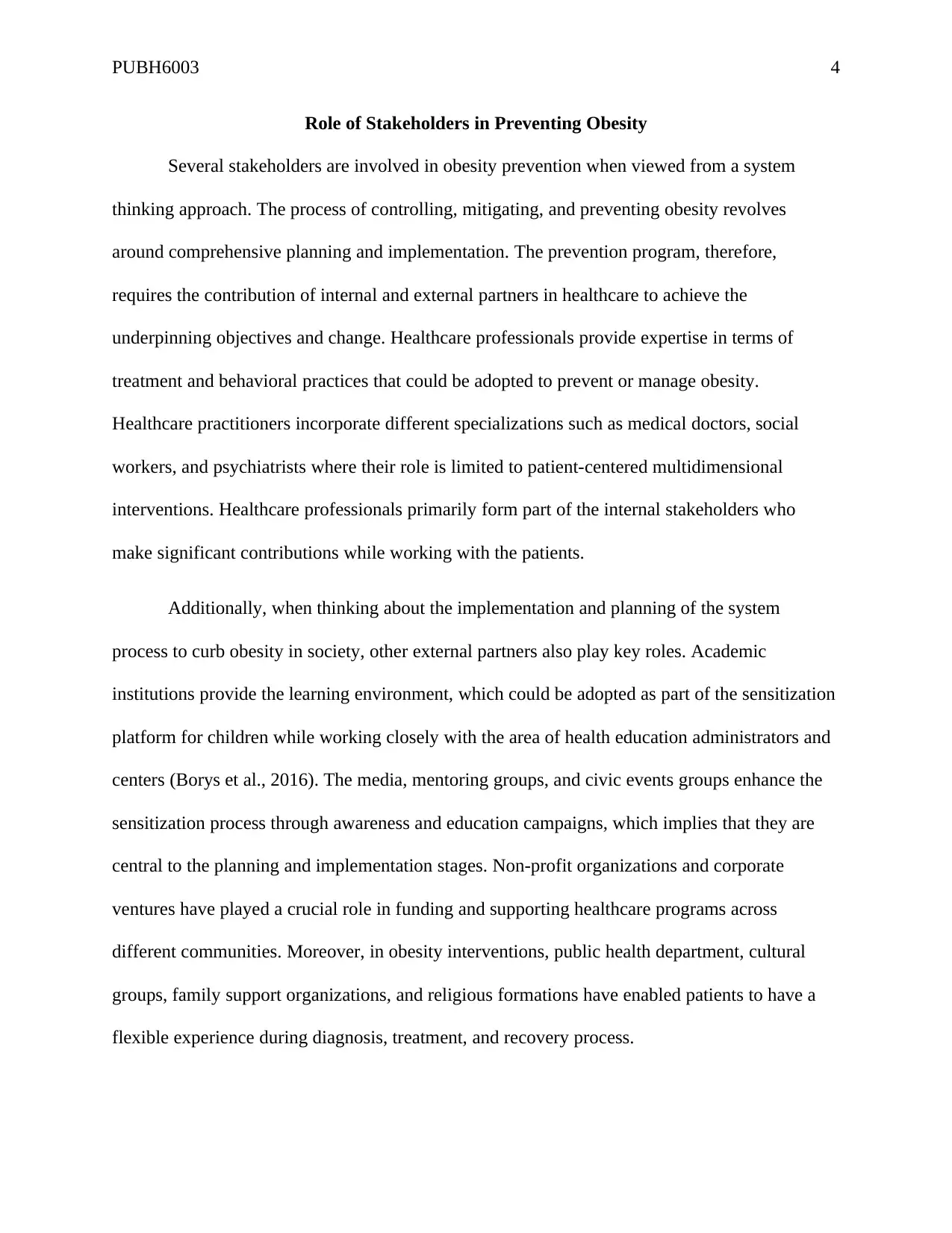
PUBH6003 4
Role of Stakeholders in Preventing Obesity
Several stakeholders are involved in obesity prevention when viewed from a system
thinking approach. The process of controlling, mitigating, and preventing obesity revolves
around comprehensive planning and implementation. The prevention program, therefore,
requires the contribution of internal and external partners in healthcare to achieve the
underpinning objectives and change. Healthcare professionals provide expertise in terms of
treatment and behavioral practices that could be adopted to prevent or manage obesity.
Healthcare practitioners incorporate different specializations such as medical doctors, social
workers, and psychiatrists where their role is limited to patient-centered multidimensional
interventions. Healthcare professionals primarily form part of the internal stakeholders who
make significant contributions while working with the patients.
Additionally, when thinking about the implementation and planning of the system
process to curb obesity in society, other external partners also play key roles. Academic
institutions provide the learning environment, which could be adopted as part of the sensitization
platform for children while working closely with the area of health education administrators and
centers (Borys et al., 2016). The media, mentoring groups, and civic events groups enhance the
sensitization process through awareness and education campaigns, which implies that they are
central to the planning and implementation stages. Non-profit organizations and corporate
ventures have played a crucial role in funding and supporting healthcare programs across
different communities. Moreover, in obesity interventions, public health department, cultural
groups, family support organizations, and religious formations have enabled patients to have a
flexible experience during diagnosis, treatment, and recovery process.
Role of Stakeholders in Preventing Obesity
Several stakeholders are involved in obesity prevention when viewed from a system
thinking approach. The process of controlling, mitigating, and preventing obesity revolves
around comprehensive planning and implementation. The prevention program, therefore,
requires the contribution of internal and external partners in healthcare to achieve the
underpinning objectives and change. Healthcare professionals provide expertise in terms of
treatment and behavioral practices that could be adopted to prevent or manage obesity.
Healthcare practitioners incorporate different specializations such as medical doctors, social
workers, and psychiatrists where their role is limited to patient-centered multidimensional
interventions. Healthcare professionals primarily form part of the internal stakeholders who
make significant contributions while working with the patients.
Additionally, when thinking about the implementation and planning of the system
process to curb obesity in society, other external partners also play key roles. Academic
institutions provide the learning environment, which could be adopted as part of the sensitization
platform for children while working closely with the area of health education administrators and
centers (Borys et al., 2016). The media, mentoring groups, and civic events groups enhance the
sensitization process through awareness and education campaigns, which implies that they are
central to the planning and implementation stages. Non-profit organizations and corporate
ventures have played a crucial role in funding and supporting healthcare programs across
different communities. Moreover, in obesity interventions, public health department, cultural
groups, family support organizations, and religious formations have enabled patients to have a
flexible experience during diagnosis, treatment, and recovery process.
Paraphrase This Document
Need a fresh take? Get an instant paraphrase of this document with our AI Paraphraser
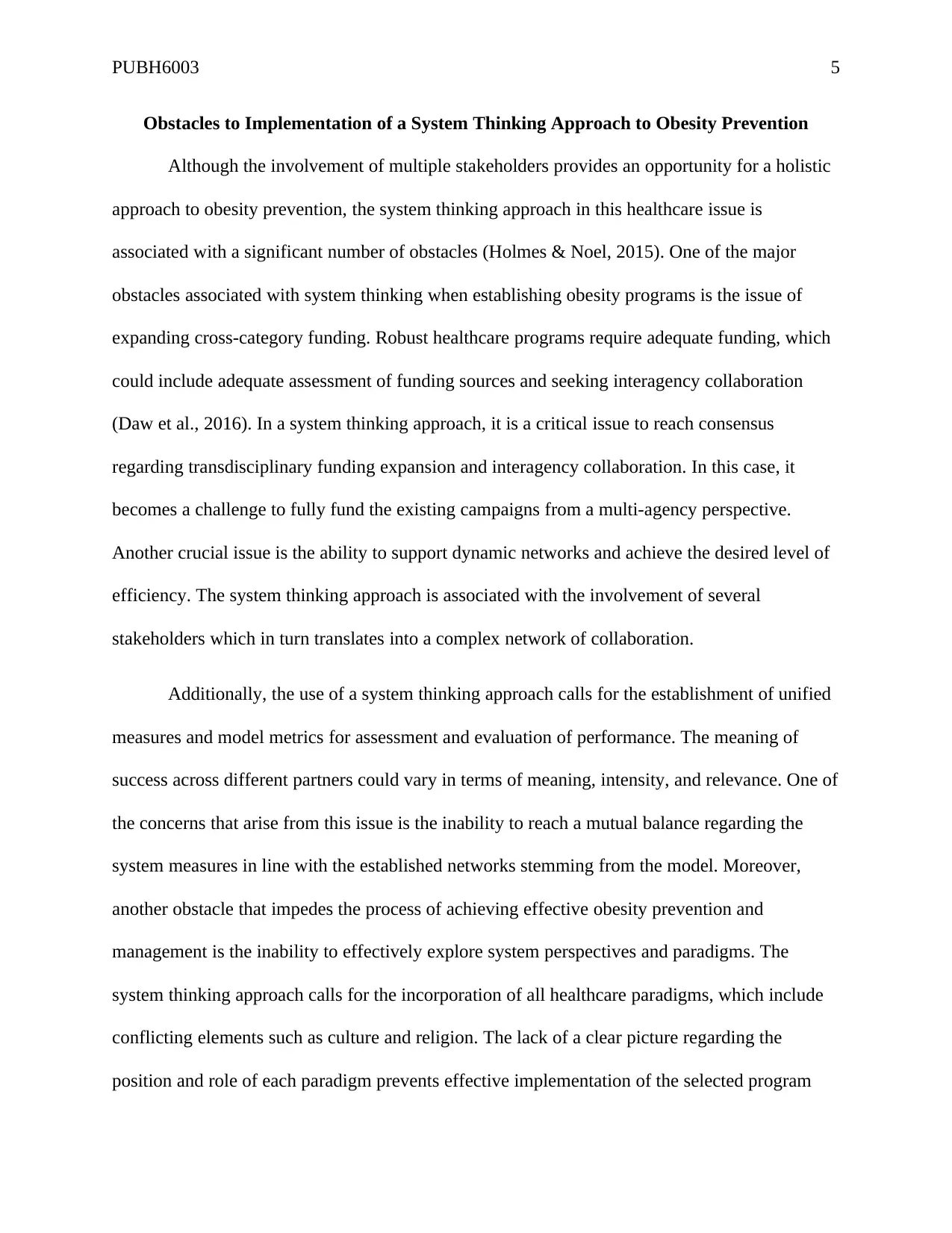
PUBH6003 5
Obstacles to Implementation of a System Thinking Approach to Obesity Prevention
Although the involvement of multiple stakeholders provides an opportunity for a holistic
approach to obesity prevention, the system thinking approach in this healthcare issue is
associated with a significant number of obstacles (Holmes & Noel, 2015). One of the major
obstacles associated with system thinking when establishing obesity programs is the issue of
expanding cross-category funding. Robust healthcare programs require adequate funding, which
could include adequate assessment of funding sources and seeking interagency collaboration
(Daw et al., 2016). In a system thinking approach, it is a critical issue to reach consensus
regarding transdisciplinary funding expansion and interagency collaboration. In this case, it
becomes a challenge to fully fund the existing campaigns from a multi-agency perspective.
Another crucial issue is the ability to support dynamic networks and achieve the desired level of
efficiency. The system thinking approach is associated with the involvement of several
stakeholders which in turn translates into a complex network of collaboration.
Additionally, the use of a system thinking approach calls for the establishment of unified
measures and model metrics for assessment and evaluation of performance. The meaning of
success across different partners could vary in terms of meaning, intensity, and relevance. One of
the concerns that arise from this issue is the inability to reach a mutual balance regarding the
system measures in line with the established networks stemming from the model. Moreover,
another obstacle that impedes the process of achieving effective obesity prevention and
management is the inability to effectively explore system perspectives and paradigms. The
system thinking approach calls for the incorporation of all healthcare paradigms, which include
conflicting elements such as culture and religion. The lack of a clear picture regarding the
position and role of each paradigm prevents effective implementation of the selected program
Obstacles to Implementation of a System Thinking Approach to Obesity Prevention
Although the involvement of multiple stakeholders provides an opportunity for a holistic
approach to obesity prevention, the system thinking approach in this healthcare issue is
associated with a significant number of obstacles (Holmes & Noel, 2015). One of the major
obstacles associated with system thinking when establishing obesity programs is the issue of
expanding cross-category funding. Robust healthcare programs require adequate funding, which
could include adequate assessment of funding sources and seeking interagency collaboration
(Daw et al., 2016). In a system thinking approach, it is a critical issue to reach consensus
regarding transdisciplinary funding expansion and interagency collaboration. In this case, it
becomes a challenge to fully fund the existing campaigns from a multi-agency perspective.
Another crucial issue is the ability to support dynamic networks and achieve the desired level of
efficiency. The system thinking approach is associated with the involvement of several
stakeholders which in turn translates into a complex network of collaboration.
Additionally, the use of a system thinking approach calls for the establishment of unified
measures and model metrics for assessment and evaluation of performance. The meaning of
success across different partners could vary in terms of meaning, intensity, and relevance. One of
the concerns that arise from this issue is the inability to reach a mutual balance regarding the
system measures in line with the established networks stemming from the model. Moreover,
another obstacle that impedes the process of achieving effective obesity prevention and
management is the inability to effectively explore system perspectives and paradigms. The
system thinking approach calls for the incorporation of all healthcare paradigms, which include
conflicting elements such as culture and religion. The lack of a clear picture regarding the
position and role of each paradigm prevents effective implementation of the selected program
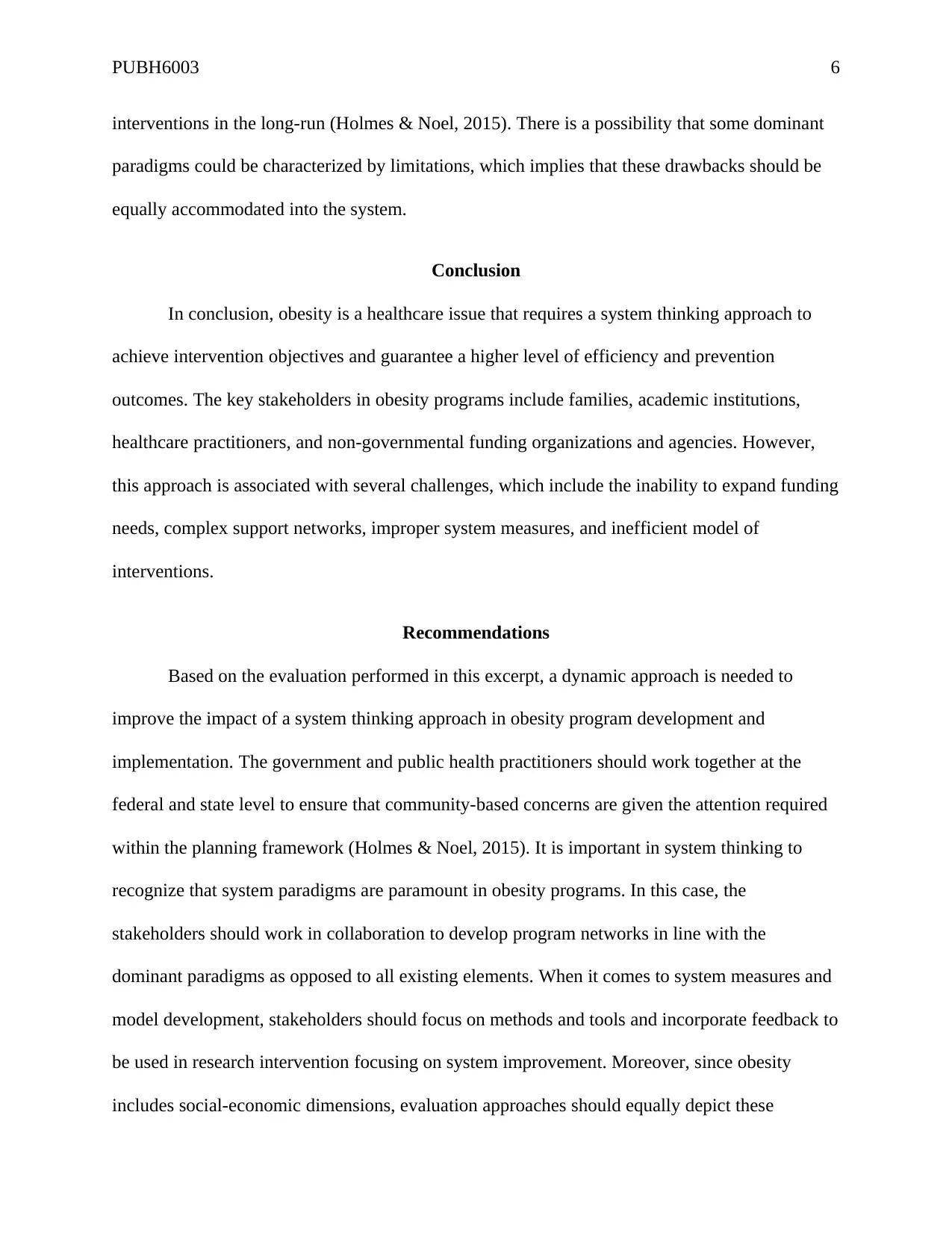
PUBH6003 6
interventions in the long-run (Holmes & Noel, 2015). There is a possibility that some dominant
paradigms could be characterized by limitations, which implies that these drawbacks should be
equally accommodated into the system.
Conclusion
In conclusion, obesity is a healthcare issue that requires a system thinking approach to
achieve intervention objectives and guarantee a higher level of efficiency and prevention
outcomes. The key stakeholders in obesity programs include families, academic institutions,
healthcare practitioners, and non-governmental funding organizations and agencies. However,
this approach is associated with several challenges, which include the inability to expand funding
needs, complex support networks, improper system measures, and inefficient model of
interventions.
Recommendations
Based on the evaluation performed in this excerpt, a dynamic approach is needed to
improve the impact of a system thinking approach in obesity program development and
implementation. The government and public health practitioners should work together at the
federal and state level to ensure that community-based concerns are given the attention required
within the planning framework (Holmes & Noel, 2015). It is important in system thinking to
recognize that system paradigms are paramount in obesity programs. In this case, the
stakeholders should work in collaboration to develop program networks in line with the
dominant paradigms as opposed to all existing elements. When it comes to system measures and
model development, stakeholders should focus on methods and tools and incorporate feedback to
be used in research intervention focusing on system improvement. Moreover, since obesity
includes social-economic dimensions, evaluation approaches should equally depict these
interventions in the long-run (Holmes & Noel, 2015). There is a possibility that some dominant
paradigms could be characterized by limitations, which implies that these drawbacks should be
equally accommodated into the system.
Conclusion
In conclusion, obesity is a healthcare issue that requires a system thinking approach to
achieve intervention objectives and guarantee a higher level of efficiency and prevention
outcomes. The key stakeholders in obesity programs include families, academic institutions,
healthcare practitioners, and non-governmental funding organizations and agencies. However,
this approach is associated with several challenges, which include the inability to expand funding
needs, complex support networks, improper system measures, and inefficient model of
interventions.
Recommendations
Based on the evaluation performed in this excerpt, a dynamic approach is needed to
improve the impact of a system thinking approach in obesity program development and
implementation. The government and public health practitioners should work together at the
federal and state level to ensure that community-based concerns are given the attention required
within the planning framework (Holmes & Noel, 2015). It is important in system thinking to
recognize that system paradigms are paramount in obesity programs. In this case, the
stakeholders should work in collaboration to develop program networks in line with the
dominant paradigms as opposed to all existing elements. When it comes to system measures and
model development, stakeholders should focus on methods and tools and incorporate feedback to
be used in research intervention focusing on system improvement. Moreover, since obesity
includes social-economic dimensions, evaluation approaches should equally depict these
⊘ This is a preview!⊘
Do you want full access?
Subscribe today to unlock all pages.

Trusted by 1+ million students worldwide
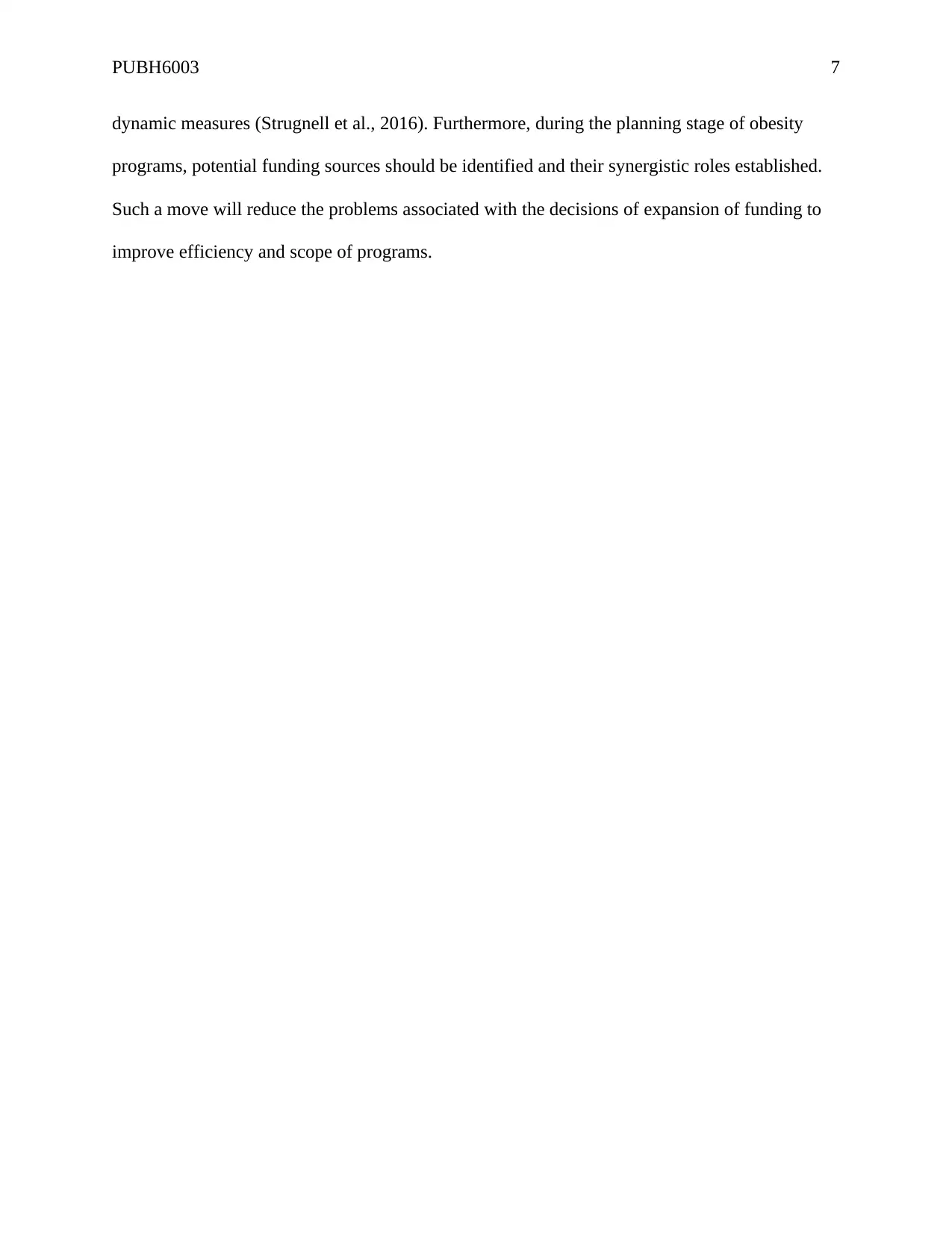
PUBH6003 7
dynamic measures (Strugnell et al., 2016). Furthermore, during the planning stage of obesity
programs, potential funding sources should be identified and their synergistic roles established.
Such a move will reduce the problems associated with the decisions of expansion of funding to
improve efficiency and scope of programs.
dynamic measures (Strugnell et al., 2016). Furthermore, during the planning stage of obesity
programs, potential funding sources should be identified and their synergistic roles established.
Such a move will reduce the problems associated with the decisions of expansion of funding to
improve efficiency and scope of programs.
Paraphrase This Document
Need a fresh take? Get an instant paraphrase of this document with our AI Paraphraser
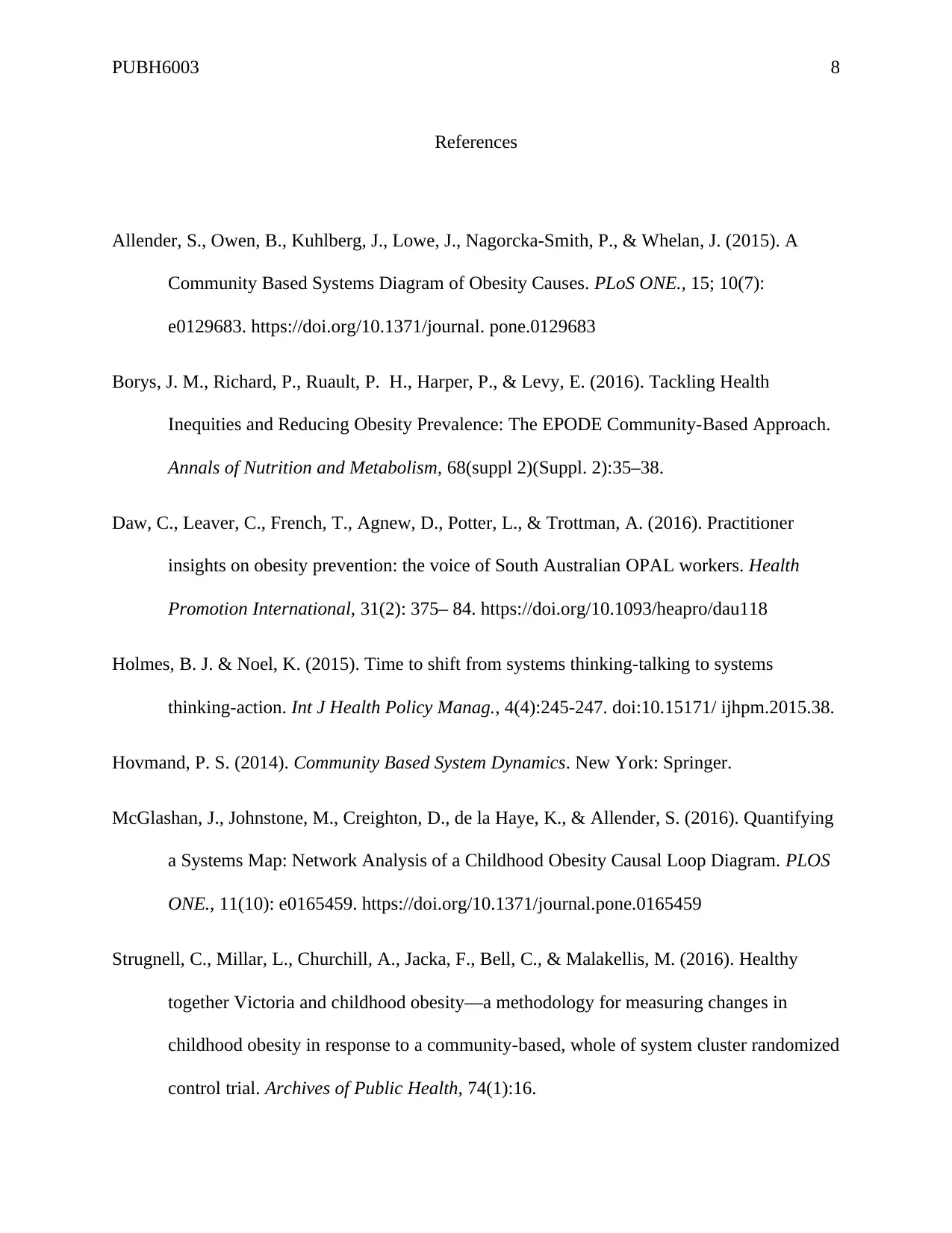
PUBH6003 8
References
Allender, S., Owen, B., Kuhlberg, J., Lowe, J., Nagorcka-Smith, P., & Whelan, J. (2015). A
Community Based Systems Diagram of Obesity Causes. PLoS ONE., 15; 10(7):
e0129683. https://doi.org/10.1371/journal. pone.0129683
Borys, J. M., Richard, P., Ruault, P. H., Harper, P., & Levy, E. (2016). Tackling Health
Inequities and Reducing Obesity Prevalence: The EPODE Community-Based Approach.
Annals of Nutrition and Metabolism, 68(suppl 2)(Suppl. 2):35–38.
Daw, C., Leaver, C., French, T., Agnew, D., Potter, L., & Trottman, A. (2016). Practitioner
insights on obesity prevention: the voice of South Australian OPAL workers. Health
Promotion International, 31(2): 375– 84. https://doi.org/10.1093/heapro/dau118
Holmes, B. J. & Noel, K. (2015). Time to shift from systems thinking-talking to systems
thinking-action. Int J Health Policy Manag., 4(4):245-247. doi:10.15171/ ijhpm.2015.38.
Hovmand, P. S. (2014). Community Based System Dynamics. New York: Springer.
McGlashan, J., Johnstone, M., Creighton, D., de la Haye, K., & Allender, S. (2016). Quantifying
a Systems Map: Network Analysis of a Childhood Obesity Causal Loop Diagram. PLOS
ONE., 11(10): e0165459. https://doi.org/10.1371/journal.pone.0165459
Strugnell, C., Millar, L., Churchill, A., Jacka, F., Bell, C., & Malakellis, M. (2016). Healthy
together Victoria and childhood obesity—a methodology for measuring changes in
childhood obesity in response to a community-based, whole of system cluster randomized
control trial. Archives of Public Health, 74(1):16.
References
Allender, S., Owen, B., Kuhlberg, J., Lowe, J., Nagorcka-Smith, P., & Whelan, J. (2015). A
Community Based Systems Diagram of Obesity Causes. PLoS ONE., 15; 10(7):
e0129683. https://doi.org/10.1371/journal. pone.0129683
Borys, J. M., Richard, P., Ruault, P. H., Harper, P., & Levy, E. (2016). Tackling Health
Inequities and Reducing Obesity Prevalence: The EPODE Community-Based Approach.
Annals of Nutrition and Metabolism, 68(suppl 2)(Suppl. 2):35–38.
Daw, C., Leaver, C., French, T., Agnew, D., Potter, L., & Trottman, A. (2016). Practitioner
insights on obesity prevention: the voice of South Australian OPAL workers. Health
Promotion International, 31(2): 375– 84. https://doi.org/10.1093/heapro/dau118
Holmes, B. J. & Noel, K. (2015). Time to shift from systems thinking-talking to systems
thinking-action. Int J Health Policy Manag., 4(4):245-247. doi:10.15171/ ijhpm.2015.38.
Hovmand, P. S. (2014). Community Based System Dynamics. New York: Springer.
McGlashan, J., Johnstone, M., Creighton, D., de la Haye, K., & Allender, S. (2016). Quantifying
a Systems Map: Network Analysis of a Childhood Obesity Causal Loop Diagram. PLOS
ONE., 11(10): e0165459. https://doi.org/10.1371/journal.pone.0165459
Strugnell, C., Millar, L., Churchill, A., Jacka, F., Bell, C., & Malakellis, M. (2016). Healthy
together Victoria and childhood obesity—a methodology for measuring changes in
childhood obesity in response to a community-based, whole of system cluster randomized
control trial. Archives of Public Health, 74(1):16.
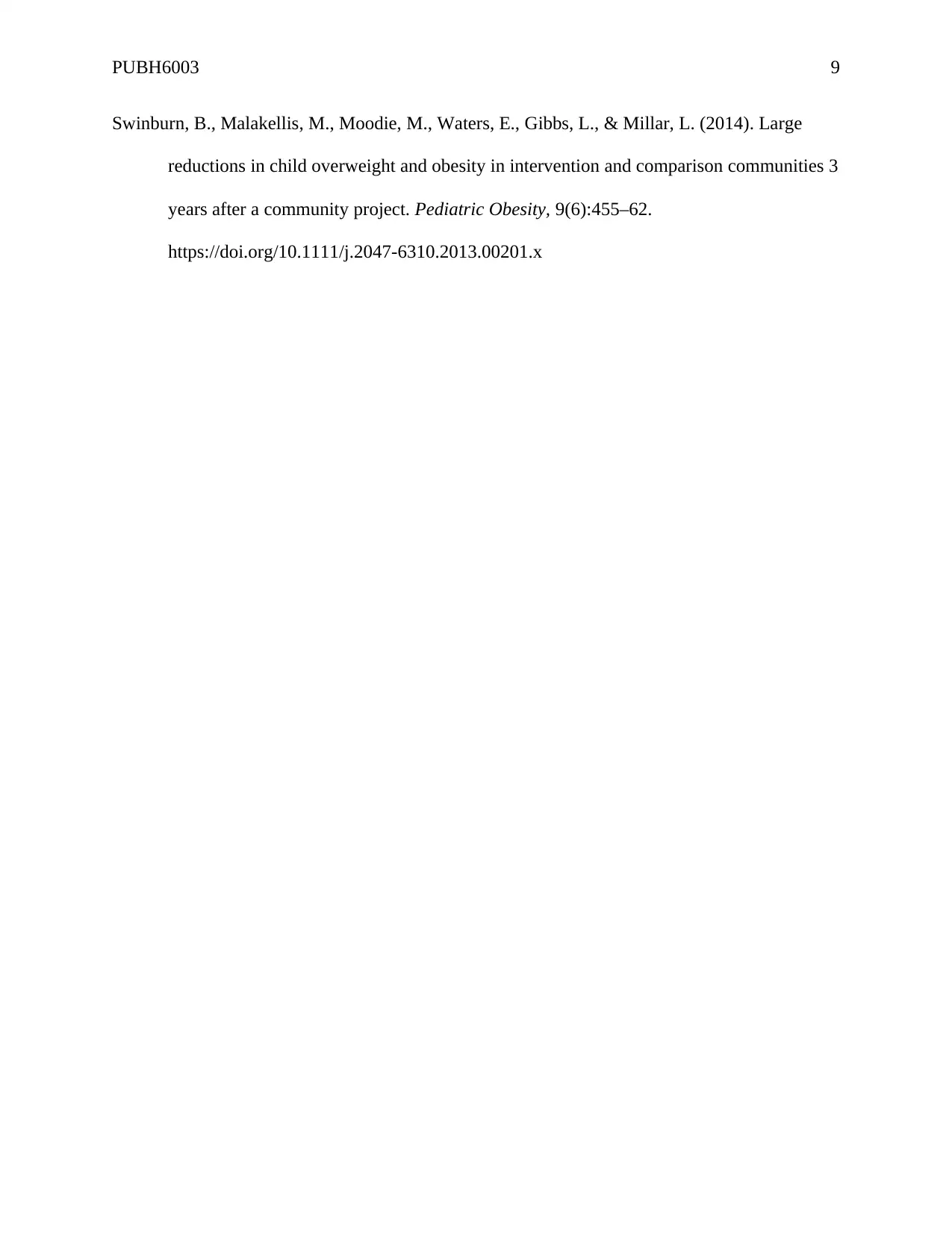
PUBH6003 9
Swinburn, B., Malakellis, M., Moodie, M., Waters, E., Gibbs, L., & Millar, L. (2014). Large
reductions in child overweight and obesity in intervention and comparison communities 3
years after a community project. Pediatric Obesity, 9(6):455–62.
https://doi.org/10.1111/j.2047-6310.2013.00201.x
Swinburn, B., Malakellis, M., Moodie, M., Waters, E., Gibbs, L., & Millar, L. (2014). Large
reductions in child overweight and obesity in intervention and comparison communities 3
years after a community project. Pediatric Obesity, 9(6):455–62.
https://doi.org/10.1111/j.2047-6310.2013.00201.x
⊘ This is a preview!⊘
Do you want full access?
Subscribe today to unlock all pages.

Trusted by 1+ million students worldwide
1 out of 9
Related Documents
Your All-in-One AI-Powered Toolkit for Academic Success.
+13062052269
info@desklib.com
Available 24*7 on WhatsApp / Email
![[object Object]](/_next/static/media/star-bottom.7253800d.svg)
Unlock your academic potential
Copyright © 2020–2025 A2Z Services. All Rights Reserved. Developed and managed by ZUCOL.





